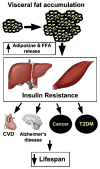Role of visceral adipose tissue in aging
- PMID: 19364483
- PMCID: PMC2779572
- DOI: 10.1016/j.bbagen.2009.01.008
Role of visceral adipose tissue in aging
Abstract
Background: Visceral fat (VF) accretion is a hallmark of aging in humans. Epidemiologic studies have implicated abdominal obesity as a major risk factor for insulin resistance, type 2 diabetes, cardiovascular disease, metabolic syndrome and death.
Methods: Studies utilizing novel rodent models of visceral obesity and surgical strategies in humans have been undertaken to determine if subcutaneous (SC) abdominal or VF are causally linked to age-related diseases.
Results: Specific depletion or expansion of the VF depot using genetic or surgical tools in rodents has been shown to have direct effects on disease risk. In contrast, surgically removing large quantities of SC fat does not consistently improve metabolic parameters in humans or rodents, while benefits were observed with SC fat expansion in mice, suggesting that SC fat accrual is not an important contributor to metabolic decline. There is also compelling evidence in humans that abdominal obesity is a stronger risk factor for mortality risk than general obesity. Likewise, we have shown that surgical removal of VF improves mean and maximum lifespan in rats, providing the first causal evidence that VF depletion may be an important underlying cause of improved lifespan with caloric restriction.
General significance: This review provides both corollary and causal evidence for the importance of accounting for body fat distribution, and specifically VF, when assessing disease and mortality risk. Given the hazards of VF accumulation on health, treatment strategies aimed at selectively depleting VF should be considered as a viable tool to effectively reduce disease risk in humans.
Figures


Similar articles
-
Removal of visceral fat prevents insulin resistance and glucose intolerance of aging: an adipokine-mediated process?Diabetes. 2002 Oct;51(10):2951-8. doi: 10.2337/diabetes.51.10.2951. Diabetes. 2002. PMID: 12351432
-
Visceral fat dominant distribution in male type 2 diabetic patients is closely related to hepatic insulin resistance, irrespective of body type.Cardiovasc Diabetol. 2009 Aug 5;8:44. doi: 10.1186/1475-2840-8-44. Cardiovasc Diabetol. 2009. PMID: 19656356 Free PMC article.
-
Visceral adipose tissue modulates mammalian longevity.Aging Cell. 2008 Jun;7(3):438-40. doi: 10.1111/j.1474-9726.2008.00391.x. Epub 2008 Mar 18. Aging Cell. 2008. PMID: 18363902 Free PMC article.
-
Contribution of adipose tissue to health span and longevity.Interdiscip Top Gerontol. 2010;37:1-19. doi: 10.1159/000319991. Epub 2010 Aug 10. Interdiscip Top Gerontol. 2010. PMID: 20703052 Review.
-
Interaction between aging and syndrome X: new insights on the pathophysiology of fat distribution.Ann N Y Acad Sci. 1999 Nov 18;892:58-72. doi: 10.1111/j.1749-6632.1999.tb07785.x. Ann N Y Acad Sci. 1999. PMID: 10842652 Review.
Cited by
-
Accumulation of γδ T cells in visceral fat with aging promotes chronic inflammation.Geroscience. 2022 Jun;44(3):1761-1778. doi: 10.1007/s11357-022-00572-w. Epub 2022 Apr 28. Geroscience. 2022. PMID: 35477832 Free PMC article.
-
Thermoregulatory phenotype of the Trpv1 knockout mouse: thermoeffector dysbalance with hyperkinesis.J Neurosci. 2011 Feb 2;31(5):1721-33. doi: 10.1523/JNEUROSCI.4671-10.2011. J Neurosci. 2011. PMID: 21289181 Free PMC article.
-
Could metabolic syndrome, lipodystrophy, and aging be mesenchymal stem cell exhaustion syndromes?Stem Cells Int. 2011;2011:943216. doi: 10.4061/2011/943216. Epub 2011 Jun 13. Stem Cells Int. 2011. PMID: 21716667 Free PMC article.
-
Short-lived diabetes in the young-adult ZDF rat does not exacerbate neuronal Ca(2+) biomarkers of aging.Brain Res. 2015 Sep 24;1621:214-21. doi: 10.1016/j.brainres.2014.10.052. Epub 2014 Nov 6. Brain Res. 2015. PMID: 25451110 Free PMC article.
-
Comparison of rapamycin schedules in mice on high-fat diet.Cell Cycle. 2014;13(21):3350-6. doi: 10.4161/15384101.2014.970491. Cell Cycle. 2014. PMID: 25485580 Free PMC article.
References
-
- Monzillo LU, Hamdy O, Horton ES, Ledbury S, Mullooly C, Jarema C, Porter S, Ovalle K, Moussa A, Mantzoros CS. Effect of lifestyle modification on adipokine levels in obese subjects with insulin resistance. Obes Res. 2003;11:1048–54. - PubMed
-
- Ramas J, Courbon A, Roche F, Bethoux F, Calmels P. Effect of training programs and exercise in adult stroke patients: literature review. Ann Readapt Med Phys. 2007;50:438–44. - PubMed
-
- Gaesser GA. Exercise for prevention and treatment of cardiovascular disease, type 2 diabetes, and metabolic syndrome. Curr Diab Rep. 2007;7:14–9. - PubMed
-
- McAuley PA, Myers JN, Abella JP, Tan SY, Froelicher VF. Exercise capacity and body mass as predictors of mortality among male veterans with type 2 diabetes. Diabetes Care. 2007;30:1539–43. - PubMed
Publication types
MeSH terms
Grants and funding
LinkOut - more resources
Full Text Sources
Other Literature Sources
Medical

